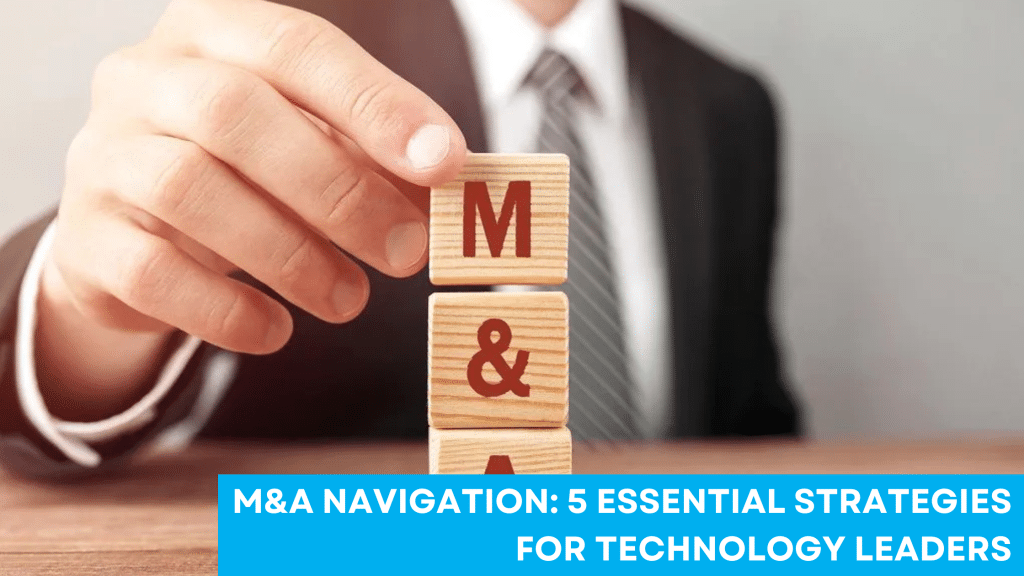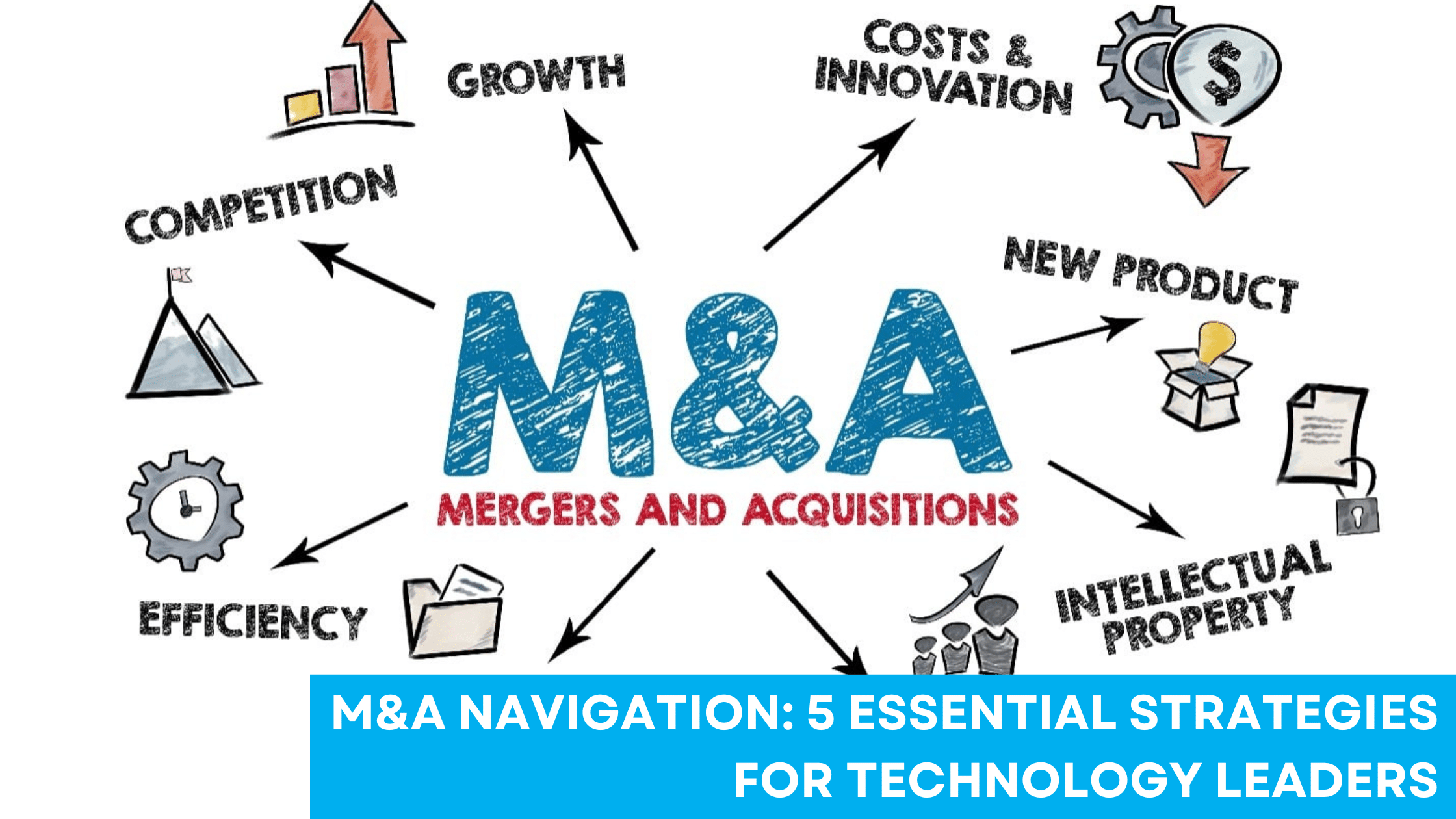Key Takeaways
- Global M&A volumes declined 9% in the first half of this year, while deal values increased 15% to $1.5 trillion, indicating a shift toward larger, more strategic transactions
- Technology sector M&A navigation requires enhanced focus on cybersecurity assessment, solution quality evaluation, and engineering strategy alignment
- 88% of corporate leaders and 81% of private equity firms have pivoted their deal targeting strategies, narrowing focus to fewer sectors for better tariff resilience
- Private credit is gaining prominence as bank lending fell from 44% to 35% of corporate borrowing, offering more flexible financing options for M&A navigation
- Cross-border M&A navigation opportunities are expanding, with 85% of dealmakers prioritizing international deals despite geopolitical uncertainties
The New Reality of M&A in Today’s Market
The mergers and acquisitions landscape presents technology leaders with an unprecedented combination of challenges and opportunities. As dealmakers navigate through what PwC describes as a period of “cautious optimism,” the traditional playbook for M&A success requires fundamental revision. Recent data demonstrates that while overall deal volumes continue to decline, strategic acquirers are increasingly focusing on larger, more transformative transactions that can deliver substantial value despite economic headwinds.
The current economic scenario is characterized by a complex web of factors that technology leaders must carefully consider when pursuing M&A opportunities. Tariff uncertainties have prompted 30% of companies to pause or revisit their deal strategies, while geopolitical tensions and policy volatility continue to reshape global capital flows. Yet beneath this surface turbulence lies a more nuanced reality: companies with strong cash flows, healthy prospects, and clear strategic vision are still actively pursuing transformative deals, particularly in sectors less susceptible to trade disruptions.
For technology leaders, this environment demands a more sophisticated approach to M&A navigation. The sector has experienced an 11% decline in deal volumes during the first half of the year, yet deal values have increased by 15%, reflecting a market that rewards strategic thinking over opportunistic dealmaking. This shift toward quality over quantity represents both a challenge and an opportunity for leaders who can adapt their strategies to align with current market dynamics.
The artificial intelligence revolution continues to drive significant M&A activity, with companies investing over $1 billion daily across research and development, capital expenditures, joint ventures, and acquisitions. This AI-driven transformation is reshaping not only the technology sector but also the fundamental approach to M&A navigation, as companies seek to acquire capabilities that will position them for long-term competitive advantage in an increasingly digital economy.
Understanding how to navigate M&A in this environment requires technology leaders to embrace new frameworks for evaluation, financing, and execution. The companies that will thrive are those that can balance strategic ambition with operational pragmatism, leveraging data-driven insights to make informed decisions while remaining agile enough to adapt to rapidly changing market conditions.
Understanding the Current M&A Landscape
The global M&A market presents a paradox that technology leaders must understand to navigate successfully. While total deal volumes have declined by 9% compared to the first half of the previous year, total deal values have surged by 15%, reaching $1.5 trillion. This divergence signals a fundamental shift in market dynamics, where strategic buyers are increasingly selective but willing to pay premium prices for assets that align with their long-term transformation goals.
Regional Performance Variations
The geographic distribution of M&A activity reveals significant variations that impact navigation strategies for technology companies. In the Americas, deal volumes declined by 12%, yet values grew by an impressive 26%, primarily driven by an increase in transactions valued at more than $1 billion. This trend reflects the market’s preference for transformative deals that can deliver substantial synergies and competitive advantages.
Asia Pacific markets have demonstrated resilience, with deal values growing 14% despite an 8% decline in volumes. Notably, India has emerged as a bright spot with deal volumes increasing by 18%, positioning the region as an attractive destination for technology companies seeking growth opportunities and supply chain diversification. This growth aligns with broader trends toward supply chain resilience and the ongoing shift of technology manufacturing away from traditional centers.
Europe, the Middle East, and Africa (EMEA) have experienced more challenging conditions, with both deal volumes and values declining by 6% and 7% respectively. However, this regional variation creates opportunities for technology leaders who can identify undervalued assets or markets where competition for quality targets may be less intense.
The Megadeal Phenomenon
One of the most significant trends shaping the current M&A landscape is the rise of megadeals. The number of deals greater than $1 billion in value has increased by 19% compared to the same period in the previous year, while transactions exceeding $5 billion have grown by 16%. This concentration of activity in larger deals reflects several key factors that technology leaders must consider in their M&A navigation strategies.
The first factor is the increasing complexity of technology transformation requirements. Companies are recognizing that incremental acquisitions may not provide the scale or capabilities needed to compete effectively in rapidly evolving markets. Instead, they are pursuing larger, more comprehensive transactions that can fundamentally reshape their competitive position.
The second factor is the availability of capital for well-positioned companies. Despite higher interest rates and tighter lending conditions, companies with strong balance sheets and clear strategic rationales continue to access capital markets for transformative deals. This has created a bifurcated market where the best assets command premium valuations while lower-quality targets struggle to attract buyer interest.
Technology Sector Dynamics
Within the technology sector specifically, M&A navigation has become increasingly sophisticated as companies grapple with the dual challenges of technological disruption and economic uncertainty. Technology deal volumes decreased by 11% in the first half of the year, yet values increased by 15%, highlighting the sector’s focus on quality over quantity.
The artificial intelligence boom continues to drive significant activity, with companies shifting their focus from large language model developers to AI infrastructure providers. This evolution reflects a maturing understanding of AI’s commercial applications and the recognition that sustainable competitive advantages lie in the underlying infrastructure and capabilities rather than in specific applications or models.
Barry Jaber, Strategy& Global Technology and Telecommunications Deals Leader at PwC UK, notes that “the promise of AI to transform the global economy is driving over $1 billion of investment per day across R&D, capex, joint ventures, and acquisitions”. This massive capital deployment is reshaping the technology M&A landscape and creating new opportunities for companies that can position themselves as essential components of the AI ecosystem.

Advanced M&A Navigation Techniques for Uncertain Markets
The complexity of the current economic environment demands that technology leaders develop sophisticated M&A navigation techniques that go beyond traditional approaches. Research from Deloitte’s M&A Trends survey, which polled 1,500 US-based corporate and private equity professionals, reveals four critical pivots that leading organizations are implementing to capture value amid current risks and uncertainties.
The Strategic Pivot: Embracing Alternative Deal Structures
One of the most significant developments in M&A navigation is the dramatic increase in alternative deal structures. Technology leaders are pursuing alternative deals—including joint ventures, strategic alliances, and initial public offerings—at a rate almost equal to traditional M&A transactions. This represents a 42% increase in alternative M&A transactions between 2022 and 2024, indicating that organizations are seeking more flexible and collaborative growth options.
This strategic pivot reflects a fundamental shift in how technology companies approach growth and transformation. Rather than pursuing outright acquisitions that require significant capital commitments and integration risks, many leaders are opting for structures that allow them to access capabilities and markets while maintaining greater flexibility to adapt to changing conditions.
Joint ventures have become particularly attractive in the technology sector, especially for companies looking to enter new geographic markets or develop emerging technologies. These structures allow companies to share both the risks and rewards of new ventures while leveraging complementary capabilities and resources. For technology leaders navigating uncertain regulatory environments, joint ventures can also provide a pathway to market entry that may face fewer regulatory hurdles than traditional acquisitions.
Strategic alliances represent another important tool in the advanced M&A navigation toolkit. These partnerships allow companies to access new technologies, customer bases, or distribution channels without the complexity and cost of full integration. In the current environment, where speed to market is often more important than perfect integration, strategic alliances can provide a competitive advantage for companies that can structure and manage them effectively.
The Targeting Pivot: Sector Focus and Specialization
The research reveals that 88% of corporate respondents and 81% of private equity respondents have made significant shifts in their deal targeting strategies over the past two years. Most notably, these shifts have involved narrowing focus to a smaller number of sectors, a strategic decision that has proven particularly important as US tariffs and reciprocal measures from other economies create varied effects across different industries.
This targeting pivot represents a sophisticated response to the current economic environment. Rather than pursuing broad diversification strategies, successful technology companies are concentrating their M&A navigation efforts on sectors where they can develop deep expertise and achieve sustainable competitive advantages. This approach allows companies to better understand regulatory risks, competitive dynamics, and integration challenges within their chosen sectors.
The focus on sector specialization also enables more effective due diligence and valuation processes. Companies that concentrate their M&A navigation efforts within specific sectors can develop proprietary insights into market trends, competitive positioning, and value creation opportunities that may not be apparent to generalist acquirers. This specialized knowledge can translate into better deal selection, more accurate valuations, and more successful post-acquisition integration.
The Geographic Pivot: Strategic Cross-Border Expansion
Despite geopolitical uncertainties, 85% of survey respondents have cross-border dealmaking near the top of their priority lists. This geographic pivot reflects a sophisticated understanding of global market dynamics and the recognition that international expansion remains essential for long-term growth, even in uncertain times.
The primary drivers of this cross-border focus are market expansion and access to technology. Technology leaders recognize that domestic markets alone may not provide sufficient growth opportunities, particularly in mature segments where competition is intense and growth rates are slowing. International markets offer access to new customer bases, emerging technologies, and talent pools that can drive innovation and competitive advantage.
However, the geographic pivot in M&A navigation is not without its complexities. Geopolitical disruptions are prompting some caution, with US dealmakers increasingly choosing to focus on markets that are geographically and politically closer to home. Canada, Mexico, and Europe have emerged as preferred destinations for cross-border M&A activity, as companies seek to shorten supply chains and reduce geopolitical risks while still accessing international opportunities.
European markets have become particularly attractive as European central banks continue aggressive rate-cutting policies, creating more favorable financing conditions for cross-border transactions. This monetary policy divergence between regions creates arbitrage opportunities for companies with sophisticated M&A navigation capabilities and access to multiple capital markets.
Strategic Financing and Deal Structure Adaptations
The financing landscape for M&A transactions has undergone a fundamental transformation, requiring technology leaders to develop new approaches to capital sourcing and deal structuring. The traditional reliance on bank lending has given way to a more diverse and sophisticated financing ecosystem that offers both challenges and opportunities for companies pursuing strategic acquisitions.
The Rise of Private Credit
One of the most significant developments in M&A financing has been the dramatic growth of private credit as an alternative to traditional bank lending. Bank lending has fallen from 44% of all corporate borrowing in 2020 to just 35% in 2023, while nonbank lending has grown significantly to fill this gap. This shift represents more than just a change in capital sources; it reflects a fundamental evolution in how companies approach M&A financing strategy.
Private credit offers several advantages that have made it increasingly attractive for technology M&A transactions. First, private credit providers often offer more flexible terms and structures than traditional banks, allowing companies to tailor financing arrangements to their specific needs and circumstances. This flexibility is particularly valuable in the current environment, where deal structures are becoming more complex and traditional financing approaches may not adequately address the unique characteristics of technology transactions.
Second, private credit can often be arranged more quickly than traditional bank financing, which is crucial in competitive deal processes where speed of execution can determine success. The ability to provide certainty of financing on accelerated timelines has become a significant competitive advantage for acquirers who can access private credit markets effectively.
The growth of private credit has been substantial, with assets under management and investment opportunities in private equity growing by approximately 15% annually over the past decade. Industry projections suggest this market will reach $2.8 trillion by 2028, indicating that private credit will continue to play an increasingly important role in M&A financing for technology companies.
Enhanced Due Diligence Requirements
The current economic environment has fundamentally changed the due diligence process, with the average due diligence timeline now taking 64% longer to complete compared to 2013, extending from 124 days to 203 days. This extension reflects the increased complexity of risk assessment in uncertain markets and the need for more comprehensive evaluation of potential targets.
Technology leaders must adapt their M&A navigation approaches to accommodate these extended timelines while maintaining deal momentum. This requires more sophisticated project management capabilities, enhanced stakeholder communication, and the ability to conduct parallel workstreams that can accelerate the overall process without compromising thoroughness.
The extended due diligence process also creates opportunities for more comprehensive value creation planning. Companies that can use the additional time to develop detailed integration plans, identify synergy opportunities, and address potential risks before closing are more likely to achieve successful outcomes. This proactive approach to integration planning has become a key differentiator in competitive deal processes.
Technology Sector-Specific Considerations
The technology sector presents unique challenges and opportunities for M&A navigation that require specialized expertise and sophisticated evaluation frameworks. As the sector continues to evolve rapidly, driven by artificial intelligence, cybersecurity concerns, and supply chain transformation, technology leaders must develop nuanced approaches to deal evaluation and execution that address the specific characteristics of technology businesses.
The AI Infrastructure Investment Supercycle
The artificial intelligence revolution has fundamentally altered the technology M&A landscape, creating what industry experts describe as a “capital expenditure supercycle” that is driving unprecedented levels of investment and acquisition activity. Major technology companies are committing massive resources to AI infrastructure development, with Microsoft reporting year-to-date capital expenditures of $49.9 billion, representing a 36% increase over the prior year period, as part of its broader $80 billion commitment to AI data centers and cloud capacity.
This AI-driven investment cycle has shifted M&A focus from companies developing large language models to those building the underlying infrastructure that enables AI deployment at scale. Technology leaders pursuing M&A opportunities in this space must understand the distinction between application-layer AI companies and infrastructure providers, as the latter often represent more sustainable competitive advantages and higher barriers to entry.
Meta’s aggressive expansion of its AI infrastructure investment, with capital expenditure guidance increased to a range of $64-72 billion (representing a 73.5% increase over the previous year’s $39.2 billion), illustrates the scale of commitment required to compete effectively in AI infrastructure. This level of investment creates both acquisition opportunities for companies with relevant capabilities and competitive pressures for those seeking to build rather than buy critical AI infrastructure components.
Cybersecurity as a Critical Evaluation Factor
The rising frequency and sophistication of cybersecurity threats have made security assessment a critical component of technology M&A evaluation. Ed Frederici, Chief Technology Officer at Appfire, emphasizes that “acquiring a company with active vulnerabilities can damage your company’s reputation and strain relationships with investors, customers, and employees”. This reality requires technology leaders to develop comprehensive cybersecurity due diligence frameworks that go beyond traditional IT assessments.
Effective cybersecurity evaluation in technology M&A requires assessment of both existing vulnerabilities and the target company’s overall approach to security. Companies must evaluate how the target’s security practices, technologies, and culture will integrate with their own security framework, ensuring that the combined entity maintains or enhances its overall security posture.
The cybersecurity evaluation process should include assessment of the target’s security infrastructure, incident response capabilities, compliance with relevant security standards, and the security awareness and training of its workforce. Technology leaders must also consider the potential impact of integration on security, as the process of combining systems and data can create new vulnerabilities if not managed carefully.
Google’s pending $32 billion acquisition of cybersecurity company Wiz demonstrates the premium valuations that quality cybersecurity assets can command in the current market. This transaction illustrates both the strategic importance of cybersecurity capabilities and the willingness of major technology companies to pay significant premiums for assets that can enhance their security posture and market position.
Solution Quality and Engineering Alignment
Beyond cybersecurity, technology M&A requires sophisticated evaluation of solution quality and technical integration requirements. This assessment must consider how well the target’s technology addresses customer needs and identify the post-acquisition investments required to unify and optimize technology platforms.
The evaluation process is particularly complex for technology companies because smaller companies often underinvest in infrastructure, while larger companies may have inefficiencies from overlapping or unlicensed tools. Technology leaders must develop frameworks for assessing these trade-offs and determining the true cost and complexity of post-acquisition integration.
For artificial intelligence solutions specifically, evaluation must ensure that the technology delivers lasting value, stands out in the market, and includes safeguards to manage consumption-based costs that can escalate and risk customer churn. The scalability of AI solutions and their readiness to integrate with broader technology portfolios are critical factors that can impact long-term customer satisfaction and operational efficiency.
The alignment of engineering practices, tools, and workflows has become a critical success factor in technology M&A transactions. Misalignment in these areas can lead to significant inefficiencies and require substantial investment to unify development processes and maintain productivity. Technology leaders must assess whether acquisitions enhance their team’s ability to innovate or introduce technical debt that could slow future progress.
Strategic Recommendations and Future Outlook
The M&A landscape for technology leaders represents both the most challenging and most opportunistic environment in recent memory. While traditional metrics suggest a market in decline—with global deal volumes down 9% and technology sector volumes declining 11%—the underlying dynamics reveal a more nuanced reality where strategic acquirers are achieving significant value through larger, more transformative transactions.
The successful navigation of M&A in this environment requires technology leaders to embrace fundamental shifts in strategy, financing, and execution. The four strategic pivots identified by leading practitioners—embracing alternative deal structures, focusing on sector specialization, pursuing strategic cross-border expansion, and adapting to extended due diligence timelines—represent more than tactical adjustments. They constitute a new framework for value creation in an era of persistent uncertainty.
Key Strategic Recommendations
Based on the analysis of current market conditions and emerging trends, several strategic recommendations emerge for technology leaders pursuing M&A opportunities:
First, embrace the shift toward larger, more strategic transactions while maintaining the flexibility to pursue alternative deal structures when appropriate. The market’s preference for transformative deals creates opportunities for companies that can think boldly about their strategic direction and execute complex transactions effectively.
Second, develop specialized expertise in target sectors rather than pursuing broad diversification strategies. The current environment rewards deep sector knowledge and the ability to identify unique value creation opportunities within specific markets.
Third, invest in sophisticated financing capabilities that can access multiple capital sources and structure deals creatively. The evolution of the financing landscape creates competitive advantages for companies that can navigate it effectively. The projected growth of private equity assets under management to $2.8 trillion by 2028 suggests that these trends will continue to reshape M&A financing for the foreseeable future.
Fourth, build comprehensive evaluation frameworks that address the unique characteristics of technology businesses, including cybersecurity, solution quality, engineering alignment, and supply chain considerations. The complexity of technology M&A requires specialized expertise and sophisticated evaluation processes.
Future Market Evolution
The technology sector’s unique position in the current M&A environment—representing 78% of deal volumes and 83% of deal values in the TMT sector—places technology leaders at the forefront of market evolution. The AI infrastructure investment supercycle, with companies investing over $1 billion daily across R&D, capital expenditures, joint ventures, and acquisitions, demonstrates the sector’s continued commitment to transformative growth despite economic headwinds.
Several emerging trends will likely shape technology M&A navigation in the coming years. The continued evolution of artificial intelligence from experimental technology to core business infrastructure will drive ongoing consolidation and capability acquisition. Companies that can identify and acquire critical AI infrastructure components early will likely achieve sustainable competitive advantages.
The growing emphasis on cybersecurity, accelerated by increasing threat sophistication and regulatory requirements, will continue to drive premium valuations for quality security assets. Technology leaders must develop comprehensive frameworks for evaluating cybersecurity capabilities and integrating security considerations into their broader M&A strategies.
Supply chain resilience will remain a critical consideration, with companies continuing to diversify their geographic footprints and reduce concentration risks. This trend will create ongoing opportunities for acquisitions that enhance supply chain visibility, flexibility, and security.
The technology leaders who can successfully implement these recommendations while navigating the complexities of the current economic environment will be well-positioned to achieve significant value creation through M&A. The market’s evolution toward larger, more strategic transactions creates opportunities for transformative growth, but only for companies that can execute effectively in an increasingly sophisticated and competitive landscape.
As the market continues to evolve, the companies that thrive will be those that view M&A navigation not as a discrete activity but as a core competency that requires ongoing investment, development, and refinement. The current environment may be challenging, but it also represents an unprecedented opportunity for technology leaders who can adapt their strategies and capabilities to meet the demands of a rapidly changing world.



